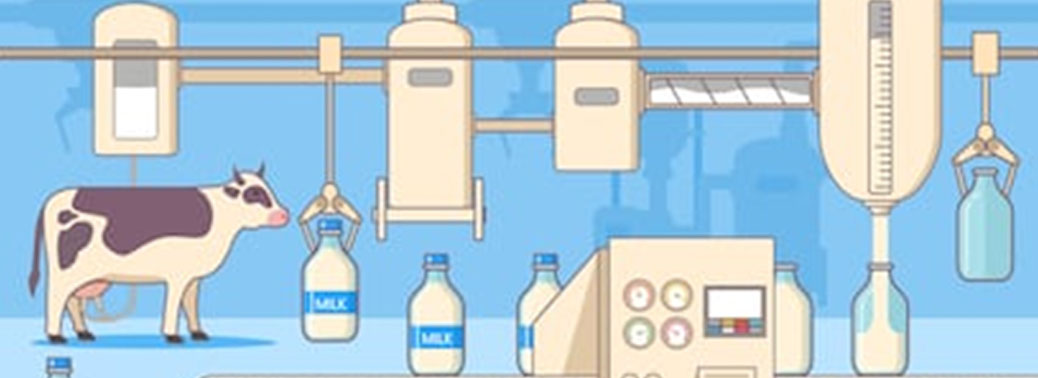DAIRY SECTOR IN INDIA
29, Feb 2020

Prelims level : Agriculture, Ignorance, Subsidy, Marketing
Mains level : GS-III Food Processing and related industries in India - scope and significance, Location, Upstream and Downstream Requirements, Supply Chain Management.
Context:
- The Cabinet Committee on Economic Affairs, has given its approval for upward revision of interest subvention to 2.5% per annum under the scheme Dairy Processing and Infrastructure Development Fund with the revised outlay of Rs 11,184 Cr.
Key Facts – Dairy Sector in Budget 2020-21:
- The government aims to “facilitate” doubling of India’s annual milk processing capacity from 53.5 million tonnes (mt) to 108 mt by 2025.
- Building a seamless national cold supply chain for perishables, inclusive of milk, meat and fish, by setting up of a “Kisan Rail” – through PPP arrangements.
- There shall be refrigerated coaches in Express and Freight trains as well.
- Eliminating Foot and Mouth disease, brucellosis in cattle and also peste des petits ruminants (PPR) in sheep and goats by 2025.
- Increasing the coverage of artificial insemination from the present 30% to 70%.
- NREGA would be dovetailed to develop fodder farms.
- The Budget Estimates for the Department of Animal Husbandry and Dairying stands at 3,289 in the Budget 2020-21.
- Recently, the Ministry of Science and Technology has launched the “Scientific Utilization through Research Augmentation-Prime Products from Indigenous Cows” (SUTRA-PIC India).
- It is one of the research programmes into indigenous cattle announced during the 2019-20 Union Budget, which aims to develop products as well as improve the genetic quality of indigenous cattle breeds.
Dairy Sector in India:
- Over the span of three decades, India has transformed from a country of acute milk shortage to the world’s leading milk producer, with estimated production of milk in 2018-19 at 187 million tonnes.
- Milk production in India has been growing at over 4% annually and its share in milk production in the world has also been increased.
- This phenomenal success is attributed to the programme ‘Operation Flood’ (1970–1996) and its intense focus on dairy development activities.
- Now, India is the leading producer and consumer of dairy products globally with sustained growth over the years.
- The dairy industry and milk hold equal importance to farmers and consumers.
Major Programmes:
- Department of Animal Husbandry And Dairying, Government of India has been supplementing the efforts of State Governments by implementing following dairy development schemes for creation/ strengthening of infrastructure for production of quality milk, procurement, processing and marketing of milk and milk products across the country:
- 1.National Programme for Dairy Development (NPDD)
- 2.Dairy Entrepreneurship Development Scheme (DEDS)
- 3.National Dairy Plan-I (NDP-I)
- 4.Dairy Processing and Infrastructure Development Fund (DIDF)
- 5.Supporting Dairy Cooperatives and Farmer Producer Organizations engaged in dairy activities (SDCFPO)
Challenges Faced by the Indian Dairy Sector:
- Milk is a source of liquidity for the farmers. It provides them with ready cash whereas crops fetch them cash only 2-3 times a year. The Indian dairy sector is different from other dairy producing countries as emphasis is placed on both cattle and buffalo milk.
- Indian dairy sector faces the following challenges:
- Productivity of Indian dairy animals is lower compared to other countries.
- Lack of scientific livestock feeding practice.
- Inadequacy and unavailability of livestock healthcare.
- Improper milk marketing facilities and uncertain price of milk for producers.
- Lack of infrastructure for milk collection, transportation, processing.
- Lack of veterinary and extension services.
- Milk losses due to lack of cold chain facilities.
- Lack of milk production standards and clean milk production practices.
Suggestions by NITI Aayog’s ‘Strategy for New India @ 75’
- Breed indigenous cattle with exotic breeds:
- Breeding of indigenous cattle with exotic breeds needs to be encouraged to arrest the issue of inbreeding.
- This will enable greater gene coverage, reduced diseases and greater resilience to climate change.
- Promote and develop Bull Mother Farms:
- Employing multiple ovulation and embryo transfer technologies, these farms can significantly enhance milk productivity through the supply of cattle with enhanced milk potential to farmers.
- Village Level Procurement Systems:
- Installing of bulk milk chillers and facilities for high value conversion of milk are needed to promote dairy in states.
- The private sector should be incentivized to create a value chain for HVCs and dairy products at the village level.
The Way Forward:
- Milk is highly perishable, therefore value addition such as processing, packaging, and conversion to long life products such as sterilized milks (UHT) is more a necessity than a luxury.
- India needs to achieve a balance between free trade and import restriction.
- Bring down the cost of production to the farmers and improve the quality and quantity of milk. This can help farmers stabilise their milk prices.
- Expand domestic demand for higher milk consumption through concerted campaigns, especially in the 115 aspirational districts where malnutrition is high.
- Indian dairy industry needs to be mechanised and modernised to achieve sustainability in the export competitive environment.
- Apart from that, the focus should also be on increasing the yields so that India can be a major player in milk and milk products’ exports.
- After the fulfilment of supplies, extra milk and milk powder can be subsidised and distributed to BPL farmers and families.
- Dairy is mainly a women-led industry so strengthening it would mean more opportunities for women and more avenues for their growth and development.






